The healthcare API market is estimated to be valued at USD 242.7 Mn in 2025 and is expected to reach USD 372.5 Mn by 2032, exhibiting a compound annual growth rate (CAGR) of 6.3% from 2025 to 2032.
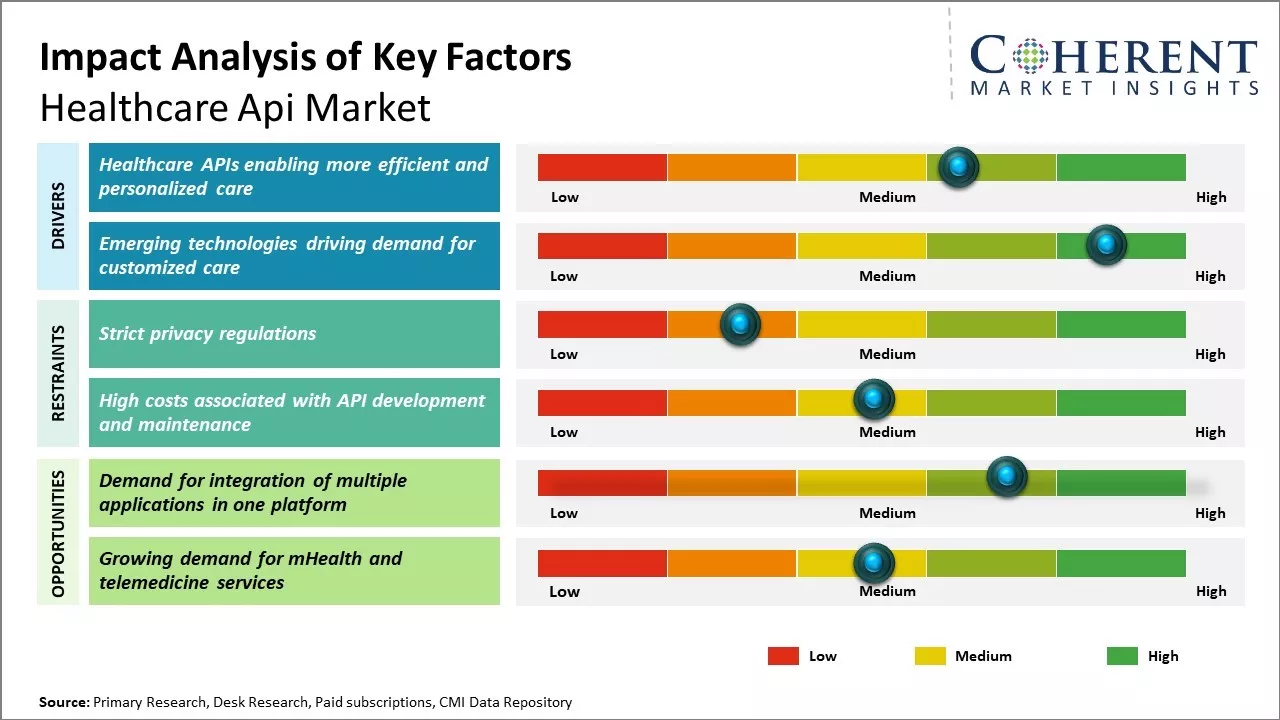
Discover market dynamics shaping the industry: Request sample copy
The growing adoption of cloud-based healthcare solutions and increasing focus on improving patient outcomes are expected to drive significant growth in the demand for Healthcare APIs. The healthcare API market is expected to witness considerable growth over the forecast period. This can be attributed to the increasing investments by pharmaceutical and healthcare IT companies to integrate APIs into their platforms and solutions. Moreover, the rising demand for more personalized care and shift towards value-based reimbursements are pressuring healthcare providers to deploy digital technologies, thereby augmenting the need for APIs.
Healthcare APIs enabling more efficient and personalized care
The healthcare industry has increasingly embraced digital transformation to improve patient outcomes and enhance the care experience. However, legacy systems remain fragmented with silos of clinical and administrative data. Healthcare APIs are allowing providers to break down these data silos by integrating disparate applications and sharing information more seamlessly. APIs are serving as the crucial middle layer that enables seamless interoperability between existing systems. This is streamlining workflows for clinicians and allowing them to focus more on direct patient care. APIs are empowering providers to access patient records, lab results, imaging scans and other critical data in real-time from a single interface. This level of data consolidation and accessibility is helping improve diagnostic and treatment decisions. APIs are also facilitating automation of routine tasks like retrieving insurance eligibility and submitting claims. This is reducing administrative burden on providers and healthcare staff.
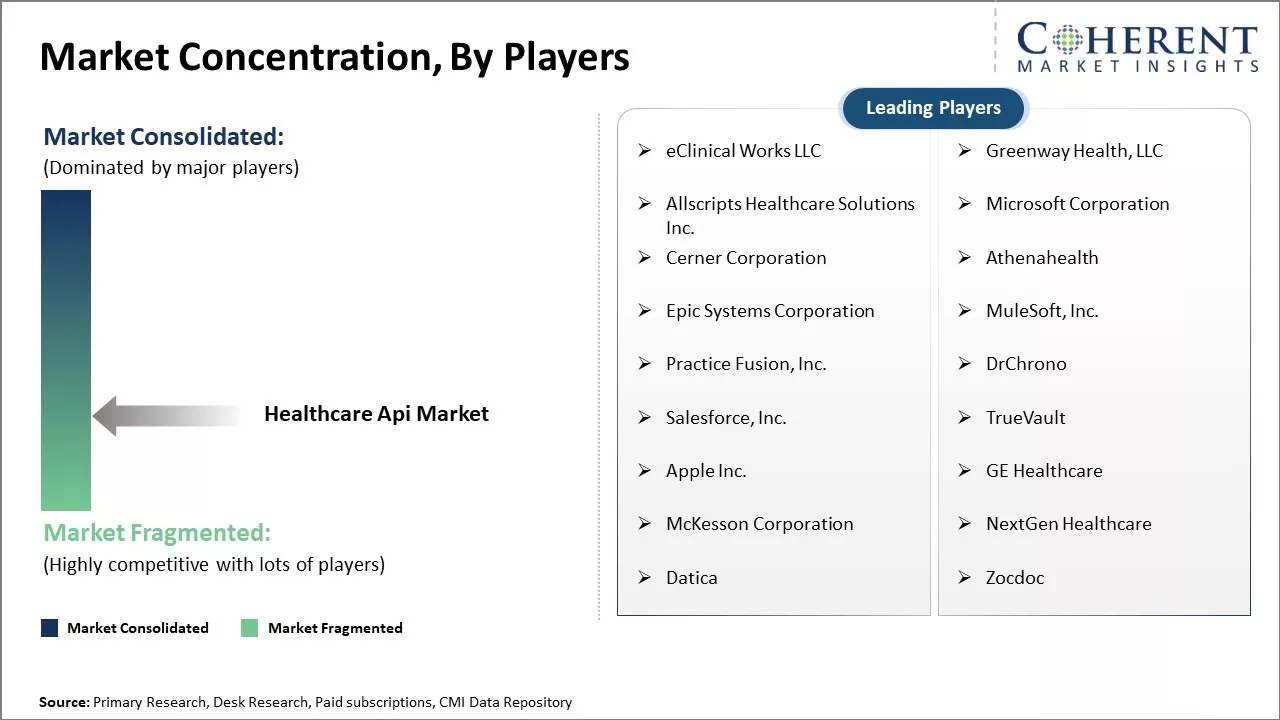
Get actionable strategies to beat competition: Request sample copy
Emerging technologies driving demand for customized careRising chronic disease burden, aging populations and increasing healthcare costs are intensifying focus on preventive strategies, remote care delivery and personalized medicine. Emerging technologies like telehealth, digital health solutions, Artificial Intelligence/Machine Learning (AI/ML) applications and wearables are improving access and facilitating more customized care approaches. However, legacy systems remain poorly equipped to support these dynamic technologies and analytic approaches. Healthcare APIs have now become essential to fully realizing the potential of these technologies by integrating disparate systems and sharing critical data sources. APIs are enabling telehealth providers to utilize patient records during virtual visits and share follow up notes with primary physicians. APIs are powering remote patient monitoring solutions by facilitating real-time transmission of vital signs and symptoms from wireless devices.
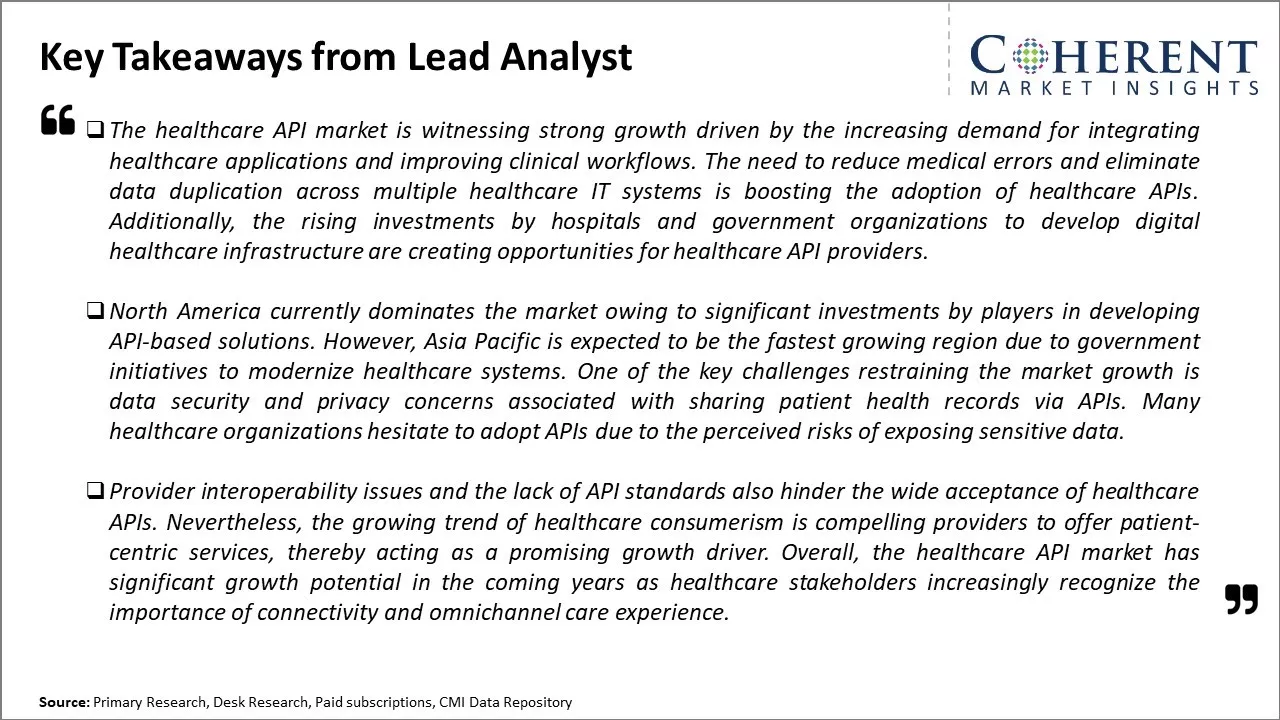
To learn more about this report, Request sample copy
Market Challenges – Strict privacy regulationsThe healthcare API market faces several challenges. Strict privacy regulations like Health Insurance Portability and Accountability Act (HIPAA) complicate how patient data can be accessed and shared through APIs. Healthcare providers also tend to prioritize patient care over technical initiatives, so investing in API development is challenging. Legacy systems make integration difficult, and a lack of standardization between providers creates silos of data. New players must convince risk-averse hospitals and insurers to embrace open APIs and new technologies.
Market Opportunities – Demand for integration of multiple applications in one platform
Demand is growing for APIs that can integrate disparate systems and power digital health tools. This opens avenues for companies to build experience layers or marketplaces on top of provider APIs. There is also a need for APIs that can analyze or transport large datasets while maintaining privacy. If these challenges can be addressed, APIs may help reduce costs, improve care coordination, and empower patients with their own medical data.
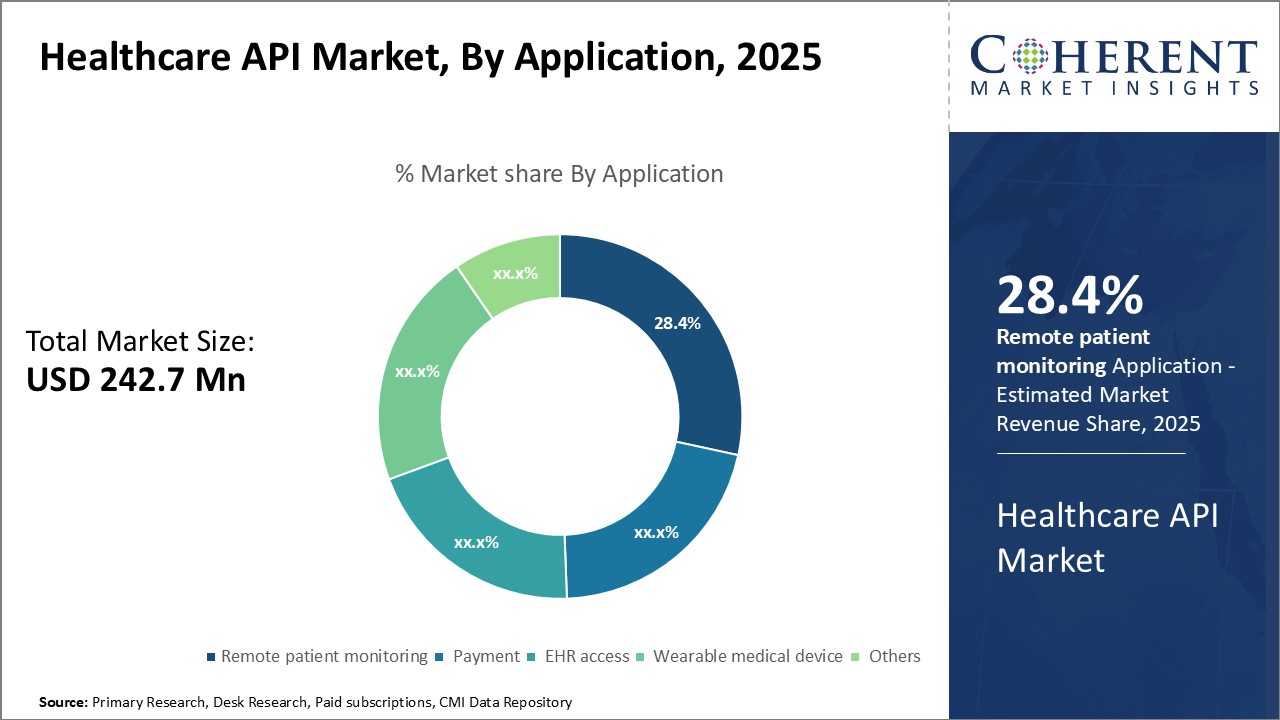
Discover high revenue pocket segments and roadmap to it: Request sample copy
Insights, By Application: Adoption of digital healthcare drives demand for EHR accessThe application segment includes remote patient monitoring, payment, EHR access, wearable medical device, and others. The EHR access segment is estimated to hold 28.4% share of the market in 2025. Healthcare providers are under growing pressure to reduce costs and improve patient outcomes, driving greater utilization of digital tools and technologies. EHR systems provide a centralized platform to securely manage patient medical records and streamline clinical workflows. However, accessing and sharing health data between different EHR systems remains challenging due to issues of interoperability. This has spurred strong demand for APIs that allow seamless transfer of EHR information. APIs enable applications to retrieve and input patient health records from multiple EHR databases, avoiding manual re-entry of data. This saves valuable time for clinicians and support staff. It also helps deliver higher quality and coordinated care by giving healthcare professionals a unified view of a patient’s medical history. APIs are therefore integral to achieving the full benefits of EHR systems through easy sharing of health information both within individual provider organizations and across different care settings.
Insights, By Deployment: Scalability, Flexibility, and Lower Costs drives cloud-based segment growth
The deployment segment includes cloud based and on premise. The cloud-based segment is estimated to hold 77.4% of the market share in 2025. Cloud platforms have emerged as the largest segment in terms of healthcare API deployment due to their scalability, flexibility, and lower costs compared to on-premise solutions. Legacy on-premise infrastructure requires substantial upfront capital expenditure on hardware, software licenses and dedicated IT resources for maintenance and support. However, cloud deployment offers a pay-as-you-go model with no major initial outlay. Providers can scale cloud-hosted API services up or down instantly as needs change, avoiding over-provisioning of resources. Transitioning API infrastructure to the cloud also lightens the management burden on in-house IT teams. Cloud vendors handle maintenance of servers, databases, networking equipment and regular software/security updates in their highly secure data centers. This frees up internal resources to focus more on strategic digital initiatives rather than day-to-day IT operations. The cloud architecture is also more resilient, with built-in redundancy and business continuity features to minimize disruptions from outages or natural disasters.
Insights, By End User: Growing adoption drives providers segment growth
The end user segment includes healthcare providers, healthcare payers, patients, and vendors. The healthcare providers segment is estimated to hold 44.4% of the market share in 2025. Traditionally, providers were reimbursed on a fee-for-service basis based solely on volume of procedures and visits. However, there is an industry-wide shift towards alternative payment models (APM) such as bundled payments, episodic payments and capitation rates based on patient outcomes. Under these models, providers assume full or partial financial risk for treating a health condition over the entire care cycle instead of single visits. To succeed in this new environment and avoid financial penalties, providers need tools for managing populations, coordinating care across settings and measuring quality metrics. Healthcare APIs are crucial enablers of population health management and value-based reimbursement programs. APIs power data aggregation and analytics solutions that give providers actionable patient insights. This helps identify at-risk individuals, close gaps in care, adhere to evidence-based guidelines, and lower overall costs through preventive interventions.
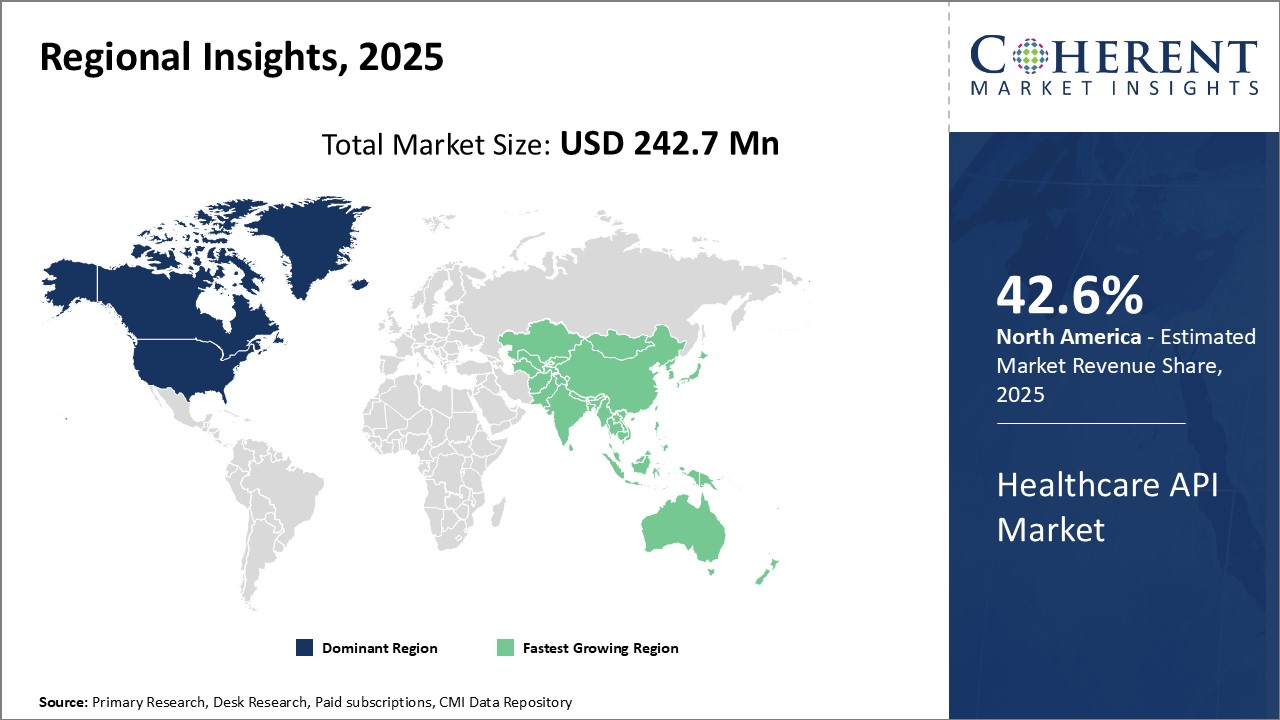
Need a Different Region or Segment? Customize now
North America has firmly established itself as the dominant region in the healthcare API market and is estimated to hold 42.6% of the market share in 2025. With countries like the U.S. and Canada having well-developed healthcare systems, there is considerable focus on digitization and integration of services. Many leading healthcare IT players have their headquarters in the region and develop cutting-edge digital health solutions. This has also led to higher adoption of APIs to facilitate connectivity across different platforms and applications. Major hospitals, insurers, and pharmacies in North America rely on APIs to share patient data, process claims and payments, and enhance patient experiences. Industry stakeholders recognize the importance of APIs in supporting value-based care models.
Asia Pacific is positioned as the fastest growing regional market for healthcare APIs. Countries like China, Japan, and India are modernizing their healthcare infrastructure at a rapid pace. There is increased government focus and spending on digital initiatives to make services accessible to wider populations. This has provided a fertile ground for API-based health solutions to take off. Asia Pacific also has a large patient pool which makes it attractive for developers. Several global healthcare IT companies have established R&D centers in Asia to tap into the development talent pool and gain first-mover advantages. Local API players in Asia Pacific cater to regional needs around electronic health records, telehealth, remote patient monitoring, and online pharmacies. The region exhibits immense untapped market potential with scope for innovations around affordable healthcare delivery solutions.
Healthcare API Market Report Coverage
| Report Coverage | Details | ||
|---|---|---|---|
| Base Year: | 2024 | Market Size in 2025: | USD 242.7 Mn |
| Historical Data for: | 2020 To 2024 | Forecast Period: | 2025 To 2032 |
| Forecast Period 2025 to 2032 CAGR: | 6.3% | 2032 Value Projection: | USD 372.5 Mn |
| Geographies covered: |
|
||
| Segments covered: |
|
||
| Companies covered: |
eClinical Works LLC, Greenway Health, LLC, Allscripts Healthcare Solutions Inc., Microsoft Corporation, Cerner Corporation, Athenahealth, Epic Systems Corporation, MuleSoft, Inc., Practice Fusion, Inc., DrChrono, Salesforce, Inc., TrueVault, Apple Inc., GE Healthcare, McKesson Corporation, NextGen Healthcare, Datica, and Zocdoc |
||
| Growth Drivers: |
|
||
| Restraints & Challenges: |
|
||
Uncover macros and micros vetted on 75+ parameters: Get instant access to report
*Definition: The Healthcare API Market provides development and access to application programming interfaces (APIs) that enable integration of various healthcare data and systems. APIs in this market allow developers to build applications that retrieve and utilize patient records, insurance information, provider directories, clinical/medical data, and other healthcare data. Healthcare organizations and technology companies use APIs from this market to develop innovative digital healthcare solutions that improve patient outcomes, streamline clinical workflows, facilitate research, and enhance data-driven decision making.
Share
Share
About Author
Manisha Vibhute is a consultant with over 5 years of experience in market research and consulting. With a strong understanding of market dynamics, Manisha assists clients in developing effective market access strategies. She helps medical device companies navigate pricing, reimbursement, and regulatory pathways to ensure successful product launches.
Missing comfort of reading report in your local language? Find your preferred language :
Transform your Strategy with Exclusive Trending Reports :
Frequently Asked Questions
Joining thousands of companies around the world committed to making the Excellent Business Solutions.
View All Our Clients
US Reciprocal Tax Impact Analysis On Healthcare API Market
Stay updated on tariff changes with expert insights and timely information